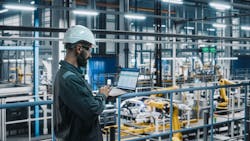Crystal Ball 2025: The opportunity for AI-powered digital transformation
A note from Scott Achelpohl, managing editor, Smart Industry:
Welcome to the Crystal Ball Report for 2025, which will appear in this web space the rest of December and into January as a series of contributed pieces from esteemed experts in manufacturing technology.
We've invited these thought leaders to look into their "crystal balls" and tell us what's ahead (with an emphasis on data, AI, and cybersecurity). So please enjoy the series and, from all of us at SI, have a happy and safe holiday season.
What's in the Crystal Ball Report for 2025:
- Crystal Ball preview: Top cybersecurity risks in 2025 and beyond, by Carlos Buenaño, Armis
- The opportunity for AI-powered digital transformation, by Aaron Merkin, Fluke Reliability
- Cybersecurity top of mind for utilities, by Sally Jacquemin, Aspen Technology
- New year will demand streamlined data management, by Dwaine Plauche, Aspen Technology
- Workforce … industrial metaverse … reshoring … sustainability … China … all 2025 focus areas, by Ethan Karp, MAGNET
- Security in 2025 won't be just for the IT team, by Joe Anderson, TechSolve
As we look toward 2025, we anticipate the manufacturing industry will continue to face many of the same challenges seen over the past few years—unstable supply chains, skilled labor shortages, sustainability concerns, and economic uncertainty. Industry trends indicate manufacturers are increasingly turning to data, AI, and machine learning to overcome these challenges.
Bonus podcast featuring Aaron Merkin: What awaits manufacturing in 2025
The push toward digital transformation remains strong, with data-driven decision-making and predictive maintenance taking center stage. Businesses will continue prioritizing efforts to collect more data and use the stream of data from IoT solutions to inform their decision-making.
One method by which manufacturers are transforming is adopting smart tools for their day-to-day processes. In addition to being used to execute the immediate task at hand, these tools support the collection and aggregation of data used to perform the task.
This data can then be used with AI to make recommendations for the next steps and enable deeper insights into decisions made not just on the plant floor but across the organization.
However, this transformation cannot depend solely on the integration of new smart tools. It hinges on the combination of all collected data from the plant floor, which includes information from smart tools, condition monitoring, maintenance records, production data, and other sources.
This comprehensive data collection empowers organizations to ask and answer critical questions: Repair or replace? What replacement parts are needed for this problem? How much will labor cost? What inventory do we need to replenish? When should we order it?
These questions can be answered using data from technologies that work together across the organization, simplifying and improving decision-making.
AI to continue bridging the skilled labor gap
The skills shortage continues to be one of the biggest concerns permeating industry. This topic comes up in nearly every industry conversation, and it's not going away, especially as seasoned experts with years of experience retire.
See also: Six ways to incorporate AI into your manufacturing operations
In our recent Fluke Reliability survey, 90% of respondents report that the skills shortage has impacted their organization. The same study showed manufacturers are turning to AI (98%) as a viable solution to help bridge the gap.
Many of our customers are leveraging automation and advanced functionality within tools to help streamline tasks and increase output with fewer hands-on roles, particularly for repetitive tasks. Additionally, the adoption of VR and AR capabilities to perform training is on the rise.
While there are still questions about the safety of AR on the factory floor, it presents an opportunity for off-floor simulation, helping people become familiar with operations before moving to the floor.
More of the Crystal Ball series:
- Insights on 2025 from talks with manufacturers, by Josh Cranfill, Quickbase
- AI, automation, and insider threat detection, by Chris Scheels, Gurucul
- Business leaders should look inward to identify what they can control, by Michael van Keulen, Coupa
- Cybersecurity trends that will reshape private content security, by Patrick Spencer, Kiteworks
- Configurability, modularity, and AI: The 2025 challenges, by Damantha Boteju, Henrik Hulgaard, and Daniel Joseph Barry, Configit
- The rise of resilient manufacturing, by Aron Brand, CTERA
- 2025 prediction thread, Part 1, by various authors
- 2025 prediction thread, Part 2, by various authors
- Your opinion counts: Results from SI's reader poll on 2025, by Scott Achelpohl, Smart Industry
A continued focus on smart tools will revolutionize manufacturing for frontline workers. The future of industrial plant maintenance is evolving, and it’s clear that electricians and plant technicians are experiencing a fundamental shift in how they interact with machines.
Smart tools are critical for driving efficiency, safety, and success. Supported by edge computing, cloud connectivity, and AI, they are more than just measurement devices—they analyze and provide actionable insights, evolving from basic tools to intelligent agents.
For example, customers are using thermal imagers to scan hundreds of drywall panels in just minutes, pinpointing defects before they lead to costly recalls or legal issues, ultimately protecting businesses from significant financial risks and empowering workers on the frontline.
Investing now in the future workforce
Filling skilled labor roles right now is challenging, but we have the tools to take steps that will alleviate the challenge in coming years.
As an industry, we need to continue focusing on what we can control: automating processes through AI to relieve teams, adopting new technology, training to upskill existing employees, and ensuring knowledge transfer from those set to retire.
Most critically, we need to keep investing in the next generation of trades persons by partnering with schools, universities, and development programs.
See also: Plan for years of 'prosperous growth’
Organizations are continuing to make significant investments in continuous learning and upskilling to keep their teams abreast of emerging technology trends. Companies are also establishing partnerships with trade schools and universities to create a pipeline of skilled employees.
We’re losing institutional knowledge along with our retiring skilled workforce, leaving behind a major experience gap. But with AI, organizations can capture that knowledge in an information storehouse.
With this information stored and accessible, organizations can use it to help upskill less experienced workers, document and share procedures across worksites, and retain experienced insights for the next generation of employees.
Stabilizing supply chains with PM and connected reliability
When we talk with customers, there’s a continued emphasis on building resilient supply chains, driven by concerns over the disruptions of the past few years. Building adaptability and transparency into supply chains has become crucial. There's also uncertainty around trade headwinds, raising questions about the reliability of overseas suppliers.
See also: The AI trap: Why manufacturers fail without the right data
As a result, businesses are exploring ways to integrate adaptability and transparency by reshoring or seeking alternate suppliers outside of potentially problematic regions and adopting dual-source strategies for critical equipment.
Technologies such as AI and predictive maintenance are being integrated into supply chain planning to predict spare parts needs well in advance, which also reduces stress from reactive fixes.
We are already seeing AI transforming predictive maintenance and process optimization, enabling manufacturers to improve uptime and efficiency while reducing costs. The ability to plan things like inventory, resources, and production is game-changing to not just efficiency but the bottom line.
Sustainability initiatives: economically prudent, environmentally conscious, and AI-driven
The current economic climate has amplified the focus on efficiency and maintaining equipment rather than replacing it. As this trend gains momentum, more businesses are looking to drive sustainable value through condition monitoring and connected reliability.
See also: The controversy surrounding DEI programs in manufacturing and beyond
Advances in technology, such as wireless sensors, have made continuous monitoring more affordable, allowing for broader asset coverage and improved efficiency. This approach cuts energy use, reduces waste, and lowers costs, demonstrating that sustainability-focused maintenance can drive both environmental and economic benefits.
Government commitments to net-zero emissions, coupled with rising consumer demands, are significantly advancing sustainability and electrification efforts.
The need for new infrastructure—such as electric vehicle (EV) charging stations, renewable energy facilities, and modernized grid components—is being driven by the demand for more efficient, resilient, and sustainable energy distribution systems.
As organizations work to comply with stricter environmental standards, achieve sustainability goals, and adhere to external regulations, digital transformation is becoming a critical strategy for success.
See also: New report reveals ‘grind’ of digital transformation, slow road to success
For example, the International Energy Agency (IEA) reported in its 2024 World Energy Investment Report that global investments in solar energy now exceed those in all other energy types combined. This emphasis on renewable energy and electrification is expected to increase the demand for advanced technologies to support these initiatives.
Here, predictive maintenance has emerged as a key focus and is increasingly being talked about in conversations around sustainable operations and the importance of optimizing equipment for both reliability and environmental impact.
By enhancing renewable energy asset availability, extending equipment lifespans, and lowering emissions, predictive maintenance supports companies’ environmental, social and governance goals. With customers placing more emphasis on sustainability, this strategy aligns operational reliability with global environmental priorities.
Deloitte reported that predictive maintenance can also result in a 5% to 15% reduction in facility downtime and a 5% to 20% increase in labor productivity. Given the skills challenges right now and the cost of downtime per minute, this is a compelling proposition for operators.
A positive vision for the future
This year, we will see significant benefits arise from the integration of AI in manufacturing.
We have observed numerous compelling pilot projects that effectively utilize these technologies, successfully identifying their optimal applications within operations.
Webinar rewind: 'Next Year’s AI' and more 2025 industrial technology insights
By adopting these advancements, manufacturers are enhancing efficiency, product quality, and significantly reducing their operational costs on a larger scale.
Yet, this represents only a small fraction of a much broader opportunity for manufacturers. The competitive advantage lies in the ability to scale these solutions to navigate ongoing disruptions and foster resilience.
By holistically integrating AI into their operations, organizations can improve their responsiveness to market demands and promote sustainable growth. As we look toward next year, the outlook is promising for manufacturers that harness the power of AI and data-driven insights. Leaders who commit to innovation will create agile and adaptive environments capable of thriving in the face of uncertainty.
About the Author

Aaron Merkin
Aaron Merkin is chief technology officer at Fluke Reliability. As CTO, he oversees development and execution of Fluke’s industrial IoT strategy and is an experienced executive in technology and product strategy, solution architecture, M&A and organizational transformation. He has more than two decades of experience developing enterprise software across a variety of industries and markets at IBM, Dell, ABB, Aclara (now Hubbell), and Honeywell.

Jason Waxman
Jason Waxman is president of Fluke Corp., a provider of electronic test tools and software for engineers, technicians, and metrologists worldwide. He became Fluke's president in June 2021, and his career spans two decades of achievements in technology product leadership and general management across datacenters, cloud computing, hardware, and software, within a multinational corporation and technology company.

